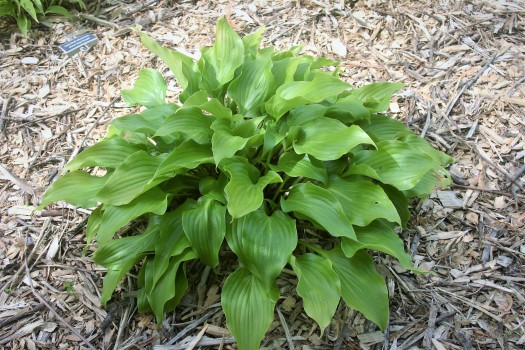Though hostas are native to Japan, China, and Korea, the majority of species come from Japan. This article is the ninth in a series which will talk about those species. Previous eNewsletter articles have covered Hosta alismifolia, H. nakaiana, H. pycnophylla, H. longipes, H. longissima, H. montana, H. kikutii and H. tibae. If you missed any of the past articles, you can find them on my blog site: https://thecottagegardener53012.wordpress.com.
Today we will discuss H. rupifraga, Hachijo Giboshi, which is named for the island on which it is found, Hachijo Island, a volcanic island in the Philippine Sea about 200 miles South of Tokyo. Hachijo Island has an area of just over 24 square miles and is part of the Izu archipelago. It receives about 120 inches of rain annually and has a humid subtropical climate. Though this may sound an alarm for Midwestern gardeners, H. rupifraga has proved to be hardy to much colder climates.
Hosta rupifraga is found in the cooler environment at the top of Mount Nishi at an elevation of about 2500 feet. The specific epithet, rupifraga, is derived from rupifragus, which means “growing in the cleft of rocks.” In its native habitat it is found growing on scree, making it useful in rock gardens. When first emerging, it may be in full sun but is shaded by tall grasses during the heat of the summer. As might be expected of a plant that is found in a limited area, it is morphologically very uniform.
Hosta rupifraga is a small plant with a mature height of 10 inches. Leaves are light to medium green, of thick substance, shiny, and slightly waxy on the underside. Margins are wavy. Its size and substance make it useful as an edging plant in the shade garden. Flowers are lavender with whitish petal margins, surrounded by white and purple bracts. They are both pollen and pod fertile. Scapes are purple dotted and grow to a height of about 18 inches. The plant blooms in September, fairly late when compared to other hostas.
Hosta rupifraga is similar to and often confused with H. longipes var. latifolia. Speculation is that H. rupifraga evolved from H. longipes var. latifolia on isolated Hochijo Island. One major difference is that the petioles of H. rupifraga are green while H. longipes var. latifolia has reddish-purple dots.
Several sports of H. rupifraga have originated in Japan. ‘Fukurin Ki Hachijo’ has golden leaves with paler margins. ‘Ki Hachijo’ has entirely golden leaves. ‘Urajiro Hachijo’ has green leaves with a thick waxy bloom on the lower side.
Hosta hybridizers have latched onto H. rupifraga’s characteristics of waxy thick leaves and late flowers in their breeding programs. Because of the confusion with H. longipes var. latifolia, however, some may have used this plant rather than the true Hosta rupifraga. ‘Forever Green’ (Dishon 94,) a cross between H. rupifraga and H. plantaginea, has fragrant lavender flowers and dark green leaves. ‘Raspberry Sorbet’ (Lohman/Zilis 99) is an attractive low dense plant with shiny green leaves and purple flowers on purplish scapes. It’s parentage is H. rupifraga x ‘Shining Tot.’ Herb Benedict crossed H. kikutii with H. rupifraga and got ‘Roy’s Pink.’ It is an earlier blooming plant with pale purple flowers. ‘Frosty Morn’ (Lachman 93) is a H. rupifraga hybrid with cupped, medium gold to chartreuse leaves and near white flowers in late July. Tony Avent’s cross between H. rupifraga and H. plantaginea resulted in ‘Surfer Dude’ (Avent 07), a plant which is heavily rippled and has a thick bloom on the underside. Flowers are purple with white stripes and are slightly fragrant. ‘Burgundy Bermudas’ (Goodwin 13) is a H rupifraga seedling that has red petioles.
A multi-plant cross, ‘Sweet Susan Streaked’ x ((H. rupifraga x ‘Fall Bouquet’) x ‘Blue Blush’) resulted in ‘Extasy’ (Hansen 07). I’m sure there’s a joke in here somewhere, but I’ll refrain! ‘Extasy’ is a small upright growing plant with a creamy white center and blue-green edge. Also by Hans Hansen is ‘Prairie Sky’ (Hansen 05). This cross between ((H. rupifraga hybrid) x ‘Maruba Iwa’) x ‘Blue Jay’ is medium sized, blue, and cupped. A recent introduction is ‘Frisian Green Waves’ (Bate Aukema 19), a cross between ‘Frisian Waving Steel’ and H. rupifraga. This small green plant with a wavy edge has red flower scapes. Just imagine your planting bed edged with this beauty!
Other seedlings and hybrids of H. rupifraga exist, but unfortunately are not readily available. Isn’t it time this species had more of a presence in your garden?



